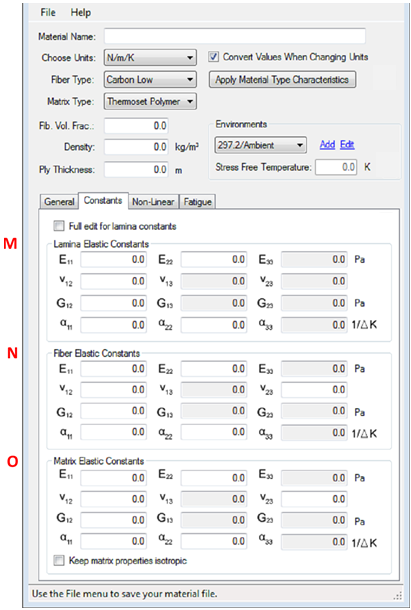Woven Constants Tab
Specify elastic constants and thermal coefficients for your woven lamina.
Fields M, N, and O below must be specified on the Constants tab.

M - Lamina Elastic Constants (required)
These are the standard woven lamina material properties.
- E11 (required): Young's modulus of lamina in the fill tow direction.
- E22 (required): Young's modulus of lamina in the warp tow direction.
- ν12 (required): In-plane Poisson ratio.
- G12 (required): In-plane lamina shear modulus.
- α11 (optional): Coefficient of thermal expansion of the lamina in the fill tow direction.
- α22 (optional): Coefficient of thermal expansion of the lamina in the warp tow direction.
If you check "Full edit for lamina constants", all lamina material constants must be specified. Checking this box means that you are confident in all of the lamina material constants. Note that use of this functionality may cause convergence issues and thus increased solution times. Checking this box requires you to specify:
- E11 (required): Young's modulus of lamina in the fill tow direction.
- E22 (required): Young's modulus of lamina in the warp tow direction.
- E33 (required): Young's modulus of the lamina in the thickness direction.
- ν12 (required): In-plane Poisson ratio.
- ν13 (required): Out of plane Poisson ratio in the fill direction
- ν 23 (required): Out of plane Poisson ratio in the warp direction
- G12 (required): In-plane lamina shear modulus.
- G13 (required): Out of plane shear modulus in the fill direction
- G23 (required): Out of plane shear modulus in the warp direction
- α11 (optional): Coefficient of thermal expansion of the lamina in the fill tow direction.
- α22 (optional): Coefficient of thermal expansion of the lamina in the warp tow direction.
- α33 (optional): Coefficient of thermal expansion of the lamina in the thickness direction.
N - Fiber Elastic Constants (required)
Helius PFA treats the fiber constituent properties as transversely isotropic. If these constituent properties are not known, Autodesk has provided default constituent properties that can be entered by selecting a fiber from the fiber type drop-down menu and clicking on "Apply Material Type Characteristics". The material type provides a starting point for fiber constituent properties which are modified when the mdata file is saved to correlate with the lamina properties you specify. If a thermal analysis is desired, the coefficients of thermal expansion must be entered. Currently, default properties are only provided for carbon, glass, and Kevlar fibers. If the coefficients of thermal expansion of the composite are left at zero, the fiber thermal expansion must also be set to zero. A description of the origin of the default material properties is provided in Appendix A.
O - Matrix Elastic Constants (required)
By default Helius PFA treats the matrix constituent properties as transversely isotropic. If you wish to force isotropic material symmetry of the matrix constituent, check the "Keep matrix properties isotropic" box. If these constituent properties are not known, Autodesk has provided default constituent properties that can be entered by selecting a matrix under the matrix type drop-down menu and clicking on "Apply Material Type Characteristics". The material type provides a starting point for matrix constituent properties which are modified when the mdata file is saved to correlate with the lamina properties you specify. Currently, default properties are only provided for thermoset, thermoplastic, and BMI resins. If a thermal analysis is desired, the coefficients of thermal expansion must be entered. If the coefficients of thermal expansion of the composite are left at zero, the matrix thermal expansion must also be set to zero. A description of the origin of the default material properties is provided in Appendix A.
